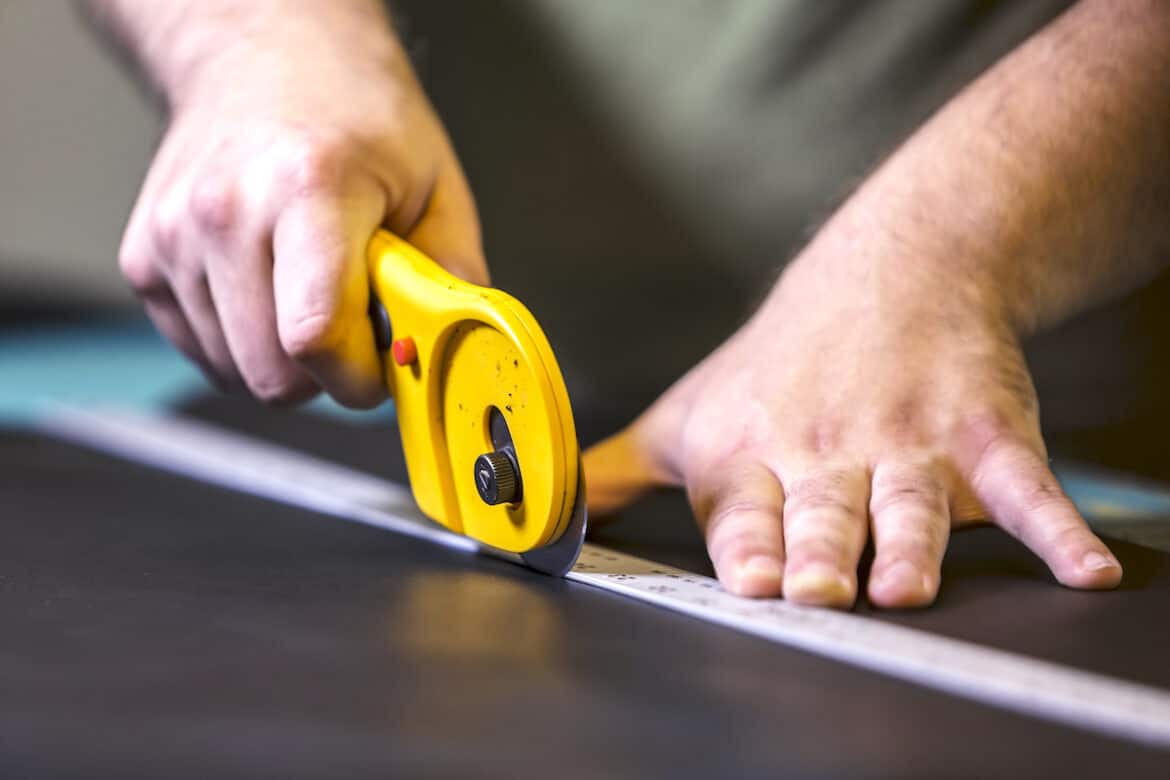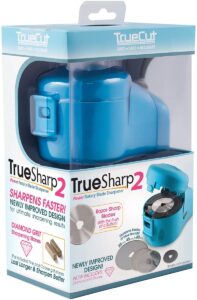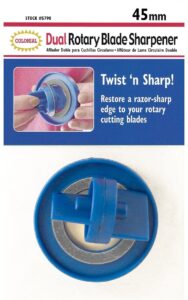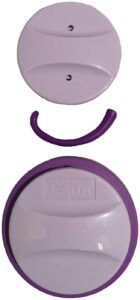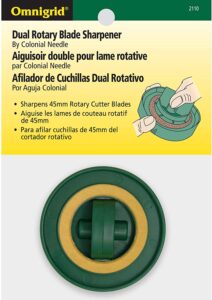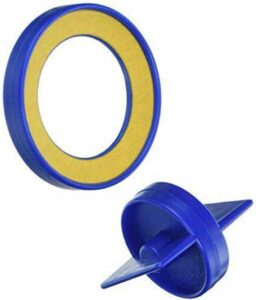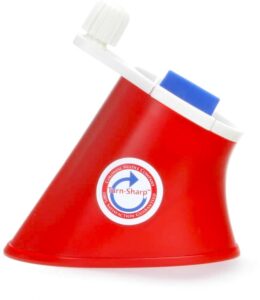Fabric seems like it would be an easy material to work with because it’s so flexible. You can lay it however you need to and shape it to fit your project.
However, this flexibility can also be a bit of a hassle sometimes. Trying to cut or pin a piece of silk to lay straight or run a smooth seam can be a nightmare.
For fabric that is too delicate, stretchy, thick, or stubborn to lay right, you may want to try using a rotary cutter. These cutters have circular blades, like a pizza cutter, that you can run across a flat piece of fabric to cut.
As you use your rotary cutter more, you may notice that the blade is getting dull. To prevent this, you can purchase a bundle of new blades, or simply invest in a rotary blade sharpener to extend the life of your current blades.
So, what is the best rotary blade sharpener? The best rotary blade sharpener is easy to use, works with multiple blade sizes, lasts long-term, and has an operational model (either manual or electronic) that works best for you.
If you don’t want to continually pay to buy new bundles of rotary blades, a rotary blade sharpener can be your best friend. Especially if you use your rotary cutter frequently to cut through difficult fabric, like leather or denim.
In this article, we’ll go over all the details you need to know to determine if you need a rotary blade sharpener and how to tell if a sharpener is good quality. We’ll also offer a list of our top recommended rotary blade sharpeners that you can purchase today!
What Is A Rotary Cutter?
A rotary cutter is a type of cutting tool for fabrics that can be used in lieu of scissors. It looks similar to a pizza cutter, comprised of a round blade held in place on a plastic (or sometimes metal) handle.
Available in different blade sizes, the most common options are 18mm, 28mm, 45mm, and 60mm. The smallest blades are perfect for patterns with a lot of intricate turns and curves, since the smaller blade gives you more control over the cutting line.
The largest blade, 60mm, is ideal for cutting through multiple layers of fabric at a time. Rotary cutters are a huge help when you’re working with fabric that’s difficult to lay flat or cut through.
If you’re working with a piece of fabric that’s particularly slick or stretchy, such as silk or cotton jersey, you may find that it’s difficult to run scissors along your marked lines correctly.
Making straight cuts is essential to getting pattern pieces to work together properly. Just as it’s important to get wood cut at just the right angle to fit together for woodworking, it’s important to line up your cuts and seams correctly with fabric.
A rotary cutter is also extremely useful for thicker fabrics, like leather. You can lay the leather down flat on your cutting mat and run the blade right through the fabric.
A final useful trick to get a rotary cutter for is to go through multiple layers of fabric. If you have a business that involves making fabric crafts for people, you’ll want the advantage of cutting several pieces of fabric at once.
Rotary cutters work great for this. As we mentioned above, if you want to cut through multiple layers of fabric with your rotary cutter, be sure to get one that’s 60mm in size.
How To Use A Rotary Cutter
Using a rotary cutter is pretty straightforward, but you do need to be mindful of safety. These blades are sharp and should always have the cover on when not in use. Before you can use a rotary cutter, you’ll need to take care of a few initial steps to prep your fabric and cutting area.
First, be sure to have a proper cutting mat in place on your work surface. You should never lay your fabric directly on a tabletop without some kind of mat underneath.
We recommend picking up a self-healing cutting mat, like this one by Crafty World. It protects your work surface and provides a ruler grid to line up your fabric properly.
Once you have your mat in place, you can lay your fabric on top. Grab your paper pattern and align it with the right area of your fabric for where you want to cut.
At this point, you can either pin the paper pattern to the paper or trace around the edges with a washable marker, then remove the paper pattern. The important thing is to ensure you know exactly where you’re going to be cutting.
Now you can remove your blade cover and start cutting. Simply roll the rotary cutter along the fabric with a light pressure, and it should cut with ease.
If your rotary cutter misses a few spots or doesn’t cut, that’s a good indication that it’s time to sharpen your blades.
Do I Need A Rotary Blade Sharpener?
Rotary blade sharpeners are necessary if you don’t want to continually buy new blades and replace them over time.
Like any other blade, your rotary blade will dull with consistent use. Just as you would sharpen your kitchen knives, you’ll need to sharpen your rotary blade.
This is typically more cost effective than purchasing new blades because it only requires one initial investment in the sharpener, then you’re good to go.
You may still need to replace your blades after a long time has passed – like after consistent use for several months or years – but overall, this will be more affordable than buying new blades every time they dull.
An important thing to remember is that your blade may develop kinks or chips. If this happens, it’s best just to replace the blade rather than sharpen it.
How To Sharpen A Rotary Blade
This may change depending on the type of rotary blade sharpener, but they’ll all have the same functionality.
First, remove the blade from your rotary cutter. Be sure to do this carefully, not touching the edge of the blade. Although it may have become dull, it can still cut if you don’t handle the blade properly.
Lay it in your rotary blade cutter – whether manual or electric, there will be a space for the blade to rest. Set it in this space.
Close up the rotary blade cutter and if it’s electric, press the start button; if it’s manual, lay the top dial on top and start twisting the dial in a circular motion.
This will grind your blade against the sharpening stones and create a sharp edge again on your dull blade.
For a visual aid in sharpening your rotary blades, check out this video by Sewing Parts Online. They have a how-to video that walks you through how to sharpen a rotary blade. It’s a great step-by-step visual for those who need that extra guidance!
The 4 Best Qualities Of A Rotary Blade Sharpener
Rotary blade sharpeners can be difficult to find – especially good quality ones.
Below we’ve listed the top 4 qualities to look for when purchasing a rotary blade sharpener. These are qualities that you’ll need to keep in mind as you shop to choose the right sharpener for you.
1. Easy To Use
A rotary blade sharpener should be easy to use. Sharpening any blade is a fairly straight-forward process, and it doesn’t need to be made harder by a complicated contraption.
If you can’t tell how it works from just looking at the pictures and reading the product description, it’s probably not the right rotary blade sharpener for you.
There are several sharpeners out there that are incredibly easy to use, so don’t settle for something difficult just because it’s the first one you find. Most rotary blade sharpeners are as easy as slipping the blade in, closing the sharpener, and twisting a dial to sharpen the blade.
The easiest rotary blade sharpeners are actually electronic, which we’ll discuss in a section below. But when looking for one that’s easy to use, it should be just as simple to use manually as it is to use electronically.
2. Multiple Blade Sizes
Once you use a rotary cutter for the first time, you’ll likely fall in love and want to get more cutters in different sizes. This means that you’ll need a rotary blade sharpener that can work with all the different sizes you own.
Most rotary blade sharpeners work on 45mm and smaller, which is fine. This will work for most rotary blades and be great for someone who makes simple projects.
For those who have a 60mm rotary cutter for large-scale projects, cutting multiple layers of fabric at a time, or need more power against tough leather, you’ll need to find a rotary blade sharpener that fits this size.
Rotary blade sharpeners for 60mm blades might be hard to find, but they’re out there! Several of our recommended products below can work with 60mm blades, so be sure to check out that section of the article.
3. Long-Lasting
The point of a rotary blade sharpener is to extend the life of your rotary blades so you don’t have to continually purchase new ones over time.
If your rotary blade sharpener itself is poor quality and breaks down after only a few weeks or months of use, then this doesn’t help you save money or extend the life of your rotary blades.
You need to find a rotary blade sharpener that is high quality and able to hold up long-term.
While some of the products we list below may look cheap, most of them are still durable and only look cheap because they have such a simple design. This is ideal if you want a rotary blade sharpener that’s easy to use!
If your rotary blade sharpener breaks down after a short period of time, it may have just been a single defective product or it could be a poor construction. You can either try the same product again or invest more money in a higher quality product.
With rotary cutters and the rotary blade sharpeners, you definitely get what you pay for. The more money you’re willing to spend, the better quality your product will be and the longer it will last.
4. Manual Vs Electric
While we were only able to find one electric rotary blade sharpener, it’s arguably the best product to get and can be a huge help compared to manual sharpeners.
With a manual rotary blade sharpener, you’ll need to twist the blade yourself to sharpen it. This can take a long time, depending on how many blades you sharpen, and may be hard on your wrists.
For people who struggle with arthritis or carpal tunnel syndrome, the manual rotary blade sharpeners may be difficult, or even impossible, to use. If this is the case for you, we recommend purchasing an electric rotary blade sharpener.
These are as simple as lifting the lid, placing the blade in the machine, closing the lid, and pressing a button. This is much easier on your wrists and won’t take as much time or manpower to sharpen your blades.
The only downside to electric rotary blade sharpeners is that they tend to be more expensive. At nearly triple the cost of a manual rotary blade sharpener, these may not be financially feasible for some people.
Not everyone needs the extra power and help of an electric rotary blade sharpener. They’re great if you need it, but not necessary if you can rotate the blade yourself.
The 7 Best Rotary Blade Sharpeners
After our in-depth review of how rotary cutters work and the best qualities of a rotary blade sharpener, you’re ready to start shopping!
Review our top recommended products listed below to find the best rotary blade sharpener for your home fabric projects. Whether manual or electric, fit for small blades or large blades, there’s no wrong choice. Just pick the one that’s best for you.
| Rank | Product | Key Features |
|---|---|---|
| 1. | TrueCut TrueSharp 2 Rotary Blade Sharpener | Diamond grit, electric, for larger blades |
| 2. | TrueCut TrueSharp Linear Sharpener Notion | Manual, easy to use, works with all sizes |
| 3. | Colonial Needle 45mm Rotary Blade Sharpener | Manual, for 45mm, twisting |
| 4. | Quilted Bear Premium Universal Rotary Blade Sharpener | 28mm-45mm, simple and easy to use |
| 5. | Omnigrid Rotary Cutter Dual Sharpener | 45mm, easy to twist |
| 6. | Ministry of Warehouse Rotary Blade Sharpener | 60mm, manual, easy to twist |
| 7. | Colonial Needle Turn-Sharp Rotary Blade Sharpener | Lever, manual |
1. TrueCut TrueSharp 2 Rotary Blade Sharpener
Although this is the most expensive product on our list, it’s also the only electronic rotary blade sharpener we found that works great and is worth the investment.
This rotary blade sharpener by TrueCut is incredibly easy to use. Simply place your rotary blade inside the machine and let it run!
It comes with two diamond grit sharpening stones, one coarse and one fine, to truly sharpen your blades and make them good as new.
Although it doesn’t fit the smallest blade size, it works well for rotary blades of 28mm, 45mm, and 60mm in size.
So for those using a smaller blade for detail work and the largest blade for bigger projects, this rotary blade sharpener can help you keep all of your blades sharp!
Customers rave about how well it works with their rotary blades and how quickly it gets the job done.
Keep in mind that if you’re using cheaper blades, you may get cheaper results. For best results with this rotary blade sharpener, it’s best to use good quality blades made of strong steel or titanium.
2. TrueCut TrueSharp Linear Sharpener Notion
Another awesome option from TrueCut, their TrueSharp Linear Sharpener is fantastic if you’re looking for a more affordable option than the electric one listed above.
This one is an ideal manual alternative to the dial design for those who have problems using their wrists due to arthritis or carpal tunnel syndrome.
Rather than laying the blade flat in the sharpener and twisting it to sharpen, you run the blade back and forth through the linear sharpener.
If you can use a rotary cutter to cut through fabric, you can use this sharpener. It relies on the same motion of simply running the blade back and forth in a straight line.
Another great thing about this rotary blade sharpener is that you don’t have to remove the blade from the rotary cutter. Leave it safely in the handle and simply roll the blade along the sharpener.
Because there’s no fitting component to this sharpener, it’s ready to use with blades in a variety of sizes, ranging from 28mm to 60mm. Whether you have a small or large rotary cutter, this sharpener will work great.
For those looking for an easy-to-use manual rotary blade sharpener, this is definitely the pick for you.
3. Colonial Needle 45mm Rotary Blade Sharpener
In the classic dial format, this rotary blade sharpener from Colonial Needle is a great option for those just looking to buy a simple, affordable rotary blade sharpener.
As we’ve mentioned a few times, this rotary blade sharpener works by twisting it like a dial. You’ll simply lay the blade in the sharpener, put the dial on top, and twist to sharpen the blade.
This sharpener only works with 45mm blades, so be sure to only purchase this one if you use that blade size.
Although it’s limited in size, it’s still a perfect option for those looking for an average-sized, simple rotary blade sharpener.
4. Quilted Bear Premium Universal Rotary Blade Sharpener
The Quilted Bear rotary blade sharpener is perfect for use with blades either 28mm or 45mm in size. This sharpener is another simple dial format, where you lay the blade flat in the sharpener and twist the dial to sharpen.
We love this rotary blade sharpener because of its sleek and easy-to-use design. It also comes with the magnetic safety strip to wrap around your blade’s edges and keep your hands safe while handling the blades.
Even better, Quilted Bear also offers a multi-pack that comes with two rotary cutters and their rotary blade sharpener for just a few dollars more.
If you’d like to get started with all the basics, we recommend purchasing this pack.
5. Omnigrid Rotary Cutter Dual Sharpener
The Omnigrid rotary cutter sharpener is another of the dial format options, but it’s also the most affordable option so far.
It only works with 45mm blades, but it does great to sharpen your blades for longer use.
This sharpener has two dial components that screw together through the hole in the middle of your blade. This keeps your blade in place on the sharpening circle and makes it easy to spin the dial along the sharpening stone.
This product is easy to use and works great to keep your blades sharp long-term. If you’re looking for the most affordable option that still gets the job done, then the Omnigrid rotary cutter sharpener is the best pick for you.
6. Ministry of Warehouse 60mm Rotary Blade Sharpener
This dial rotary blade sharpener is a manual option that works for 60mm rotary blades.
For those that only work with a 60mm rotary cutter because you work primarily with bulk projects or extremely thick fabric, then this rotary blade sharpener is a great option for you.
It does have the same dial format as many of the other options, so it’s as easy as spinning the blade in a circle several times to grind it against the sharpening stone.
It’s a bit more of an investment than some of our other dial options, but that’s due to the larger size and its ability to work with 60mm blades.
7. Colonial Needle Turn-Sharp Rotary Blade Sharpener
Our last option is the Colonial Needle rotary blade sharpener.
Although this sharpener also works with a dial spinning motion, it has a full housing component to keep you from having to hold the sharpener in your hand.
Instead, you’ll place the blade in the housing component, put the dial on top, and spin it around with the easy handle to sharpen the blade quickly.
This can be helpful if you want a manual rotary blade sharpener, but have trouble holding it in your hand as you sharpen.
Up Next: Reciprocating Saw Vs Circular Saw
